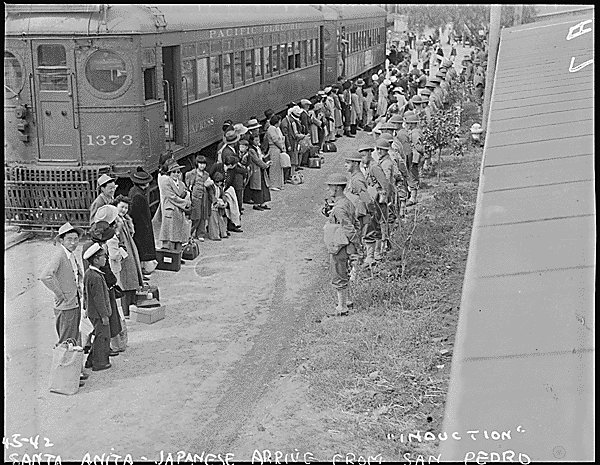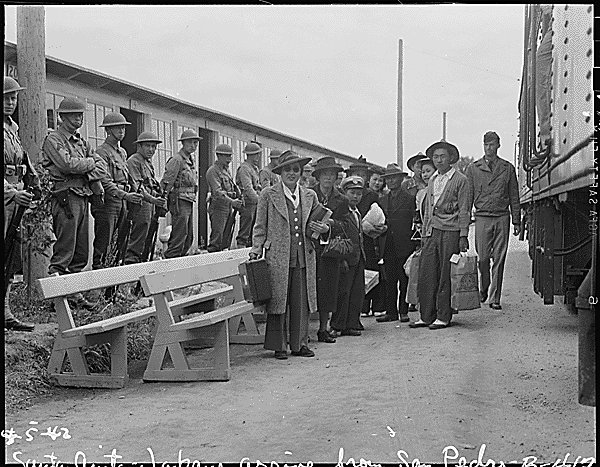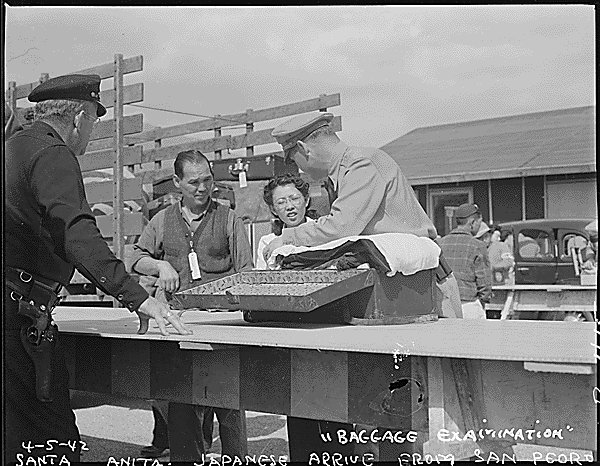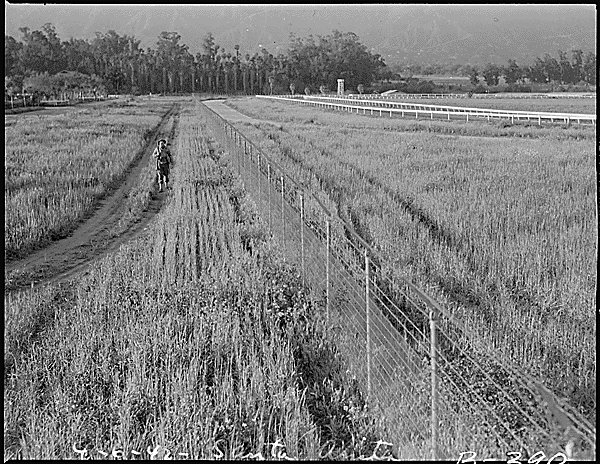In the winter of 1941-42, Dorothea Lange abandoned a Guggenheim Fellowship and took an assignment with the US War Relocation Authority in order to document the evacuaton of Americans of Japanese ancestry from the West Coast. The wikpedia article on
Japanese American internment during World War II treats this complex subject succinctly and without prejudice. Many Americans reacted hysterically to the attack on Pearl Harbor, December 7, 1941, as is evident from the first photo shown below (which is not one of Lange's).[1]

Many others refused to demonize Japanese-Americans and Americans of Japanese descent. One in particular deserves mention. General Delos Emmons, the military governor of Hawaii opposed efforts to intern Japanese Americans. In a radio address shortly after the Japanese attack, Emmons assured these residents: "There is no intention or desire on the part of the federal authorities to operate mass concentration camps. No person, be he citizen or alien, need worry, provided he is not connected with subversive elements."[2] As a result, the part of America with the greatest concentration of these people of Japanese ancestry did not participate in the internment program while on the West Coast of the US forcible removal was prompt and thorough. In March and April of 1942 more than 100,000 Americans were transported to inland camps.[3] Lange's photos documented the evacuation thoroughly. Because they dispassionately revealed an unpleasant side of life in the US, the Army impounded the whole collection for the duration of the war. As one source comments, she showed the diffiulty Americans of Japanese ancestry faced in having to leave their homes and create new lives in the camps. "Her images often juxtapose the human side and the courage of the people who were being moved, with their harsh living conditions and the inhumanity of living within barbed wire."[4]

{Caption: San Francisco, Calif., Mar. 1942. A large sign placed in the window of a store, at 13th and Franklin streets, on December 8, the day after Pearl Harbor. The store was closed following orders to persons of Japanese descent to evacuate from certain West Coast areas.}

{Caption: San Francisco, Apr. 1942; Civilian Exclusion Order #5, posted at First and Front streets, directing removal by April 7 of persons of Japanese ancestry}

{Caption: San Francisco (Calif.) evacuation - a family starts for the bus that will take them from the control station to the train depot}

{Caption: San Francisco, Calif. Apr. 1942. Part of the contingent [of] 664 residents of Japanese ancestry, first to be evacuated from San Francisco, under the US Army exclusion order No. 20, who will be housed in War Relocation Authority centers for the duration of the war}

{Caption: Los Angeles, Calif., April 1942 - A shop just before Japanese were evacuated from "Little Tokyo"}

{Caption: San Francisco, Calif., April 1942. First-graders, some of Japanese ancestry, at the Weill public school pledging allegience to the United States flag. The evacuees of Japanese ancestry will be housed in War relocation authority centers for the duration of the war}

{Caption: Oakland, Calif. Apr. 1942. Members of the Japanese Independent congregational church attending Easter services prior to evacuation of persons of Japanese ancestry from certain West Coast areas, and housing in War relocation authority centers for the duration of the war}
Detail:


{Caption: San Francisco, Calif., Apr. 1942 - residents of Japanese ancestry, in response to the US Army's Exclusion order No. 20, appearing at the Civil control station and being registered for housing in War relocation authority centers for the duration of the war}

{Caption: San Pedro, Calif. Apr. 1942. The last Redondo Beach residents of Japanese ancestry leaving by truck for relocation}
Detail:


{Caption: Photographer is unknown. Persons of Japanese ancestry arrive at the Santa Anita Assembly center from San Pedro, California. Evacuees lived at this center at the Santa Anita race track before being moved inland to relocation centers; source:
Japanese-American Internment Camps }

{Caption: Photographer is unknown. Evacuees of Japanese ancestry from San Pedro, California, arrive by special trains for Santa Anita assembly center. Evacuees are transferred later to War Relocation Authority centers for the duration. Same source.}

{Caption: Photographer is unknown. All baggage is inspected before newcomers enter Santa Anita assembly center for evacuees of Japanese ancestry. Evacuees are transferred later to War Relocation Authority centers for the duration. Same source.}

{Caption: Photographer is unknown. Military police patrol fence around Santa Anita park assembly center for evacuees of Japanese ancestry. Evacuees are later transferred to War Relocation Authority centers for the duration. Same source.}

{Caption: Photographer is unknown. Cafeteria style assures promptness in serving meals at Santa Anita assembly center for evacuees of Japanese ancestry. Passing into dining hall for lunch. In the smallest dining hall, more than 2000 meals are served in less than an hour. Evacuees are transferred later to War Relocation Authority centers for the duration. Same source.}

{Caption: Amer. Legion and Boy Scouts in Memorial Day services at Manzanar relocation center}
This photo is only indirectly about relocation to the camps.

{Caption: Photographer is unknown. Regimental Combat Team squad leader looks for German momvements in a French valley 200 yards away. Snow, rain and mud made life miserable for these Japanese-American front line troops in November 1944. The 442nd Regimental Combat Team, which was composed primarily of Japanese Americans, served with uncommon distinction in the European theatre of World War II. Many of the US soldiers serving in the unit had their families interned at home while they fought abroad. Source: Army Center for Military History file photo}
This photo shows Lange herself taking photos of evacuees on 6 April 1942.

{Caption: Japanese-Americans assemble at control station, 1701 Van Ness Ave., San Francisco, for evacuation to Santa Anita assembly center camp; Dorothea Lange is holding camera in background}
-----------
See also:
The Preservation of a People: A Look at the Evacuation and Relocation of the People of Japanese Ancestry in the United States during World War IIAgainst the TideThe Photographs of Dorothea Lange (1895-1965)Japanese American internmentDorothea Lange’s Images of the WWII Internment of People of Japanese AncestryDorothea Lange wikipedia article
Internment Without Charges: Dorothea Lange and the Censored Images of Japanese American InternmentSanta Anita Racetrack Assembly Center,(Arcadia) CaliforniaA Short Chronology of Japanese American HistoryThe Japanese InternmentReport of the Commission on Wartime Relocation and Internment of Civilians------------
Notes:
[1] Unless otherwise noted, all images are by, or believed to be by Dorothea Lange and come from collections in the Library of Congress. Click to view full size. In some cases attribution to Dorothea Lange is uncertain. Even where I've put "photographer is unkown" the photos may well have been taken by her. They're of the same time frame and subject as the ones she's known to have taken and have the same qualities and point of view. Lange was born May 26, 1895, so, as it happens, yesterday was the 115th anniversary of her birth.
[2] Source:
Japanese American internment during World War II: a history and reference guide by Wendy L. Ng (Greenwood Publishing Group, 2002)
[3] Same source. In 1988, Congress passed and President Ronald Reagan signed legislation which apologized for the internment on behalf of the U.S. government. The legislation stated that government actions were based on "race prejudice, war hysteria, and a failure of political leadership".
[4] It's not relevant to my story, but, as it happens, the camps were set up and people moved into them just at the time I was born.
























No comments:
Post a Comment